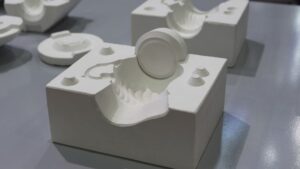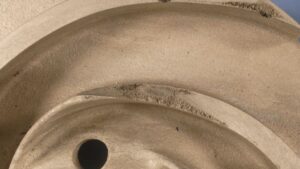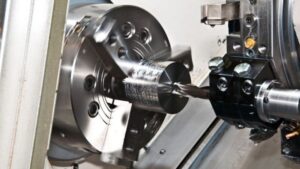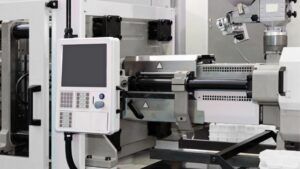Polyvinyl Chloride (PVC) injection molding stands out as a versatile and reliable manufacturing process that fulfills these requirements with exceptional proficiency.
Whether you’re producing automotive components, consumer goods, medical devices, or construction materials, PVC injection molding offers unparalleled advantages in terms of cost-effectiveness, durability, and design flexibility.
What is PVC Injection Molding?
In PVC injection molding, polyvinyl chloride (PVC), a common synthetic plastic polymer, is used to create strong and durable products. This process is key in manufacturing because of PVC’s chemical resistance and versatility.
PVC is short for polyvinyl chloride, a widely used thermoplastic. It’s popular because it combines durability with flexibility. During the plastic injection molding process, PVC is heated until it becomes liquid and then injected into a mold to form a specific shape.
Why Choose PVC Plastic as Injection Molding Material?
PVC’s chemical resistance makes it ideal for products that encounter chemicals or moisture. PVC doesn’t easily absorb water, making it useful for outdoor applications. Besides, it is flame-resistant, adding another layer of safety.
Another key benefit of PVC injection molding is its cost-effectiveness. PVC is relatively inexpensive, which makes it an attractive option for manufacturers.
Moreover, PVC has good tensile strength, which helps when creating products that require resilience. Another advantage is PVC’s ability to retain properties without absorbing moisture, making it perfect for environments where reliability is crucial.
Choosing PVC can lead to environmentally friendly options, as it is recyclable and allows for the production of high-quality products with high precision. This versatility ensures it meets the diverse needs of various industries.
The PVC Injection Molding Process
PVC injection molding is a popular way to create plastic products. It involves transforming solid PVC pellets into liquid form, injecting them into a mold, and then forming them into intricate shapes. Here’s how the process unfolds.
Heating and Melting
The journey starts in the injection molding machine. You begin by placing PVC pellets into a hopper. These pellets are then heated to a specific melt temperature range, usually between 212°F to 500°F.
Temperature control is crucial because PVC can decompose if overheated. The machine uses a screw mechanism to apply pressure and mix the heated PVC until it reaches a fluid state. This ensures that the material flows smoothly into the mold.
Molding and Cooling
Once melted, the PVC is injected into a mold under high pressure. The design of the mold is significant for achieving the final product’s shape and details. Attention to detail, such as draft angles, helps in the easy removal of the cooled product.
The cooling process is essential to let the PVC solidify. Proper cooling time is vital; too quick or slow can impact the product’s quality. Mold temperature also affects how the PVC sets.
Post-Processing
After cooling, you remove the plastic product from the mold. Sometimes, post-processing is required to achieve the desired appearance and functionality.
PVC products might need trimming to get rid of excess material. Additional processes like decorating or applying finishes might also be necessary. Since PVC can absorb moisture during storage, it may need drying before it’s packed or further processed. This keeps the quality and durability of the product intact.
How to Achieve Effective Molten PVC Injection?
Achieving a smooth and efficient injection process in PVC injection molding hinges on the precise control of both Injection pressure (back pressure) and injection speed (screw speeds).
These two parameters ensure that molten PVC is adequately melted, thoroughly mixed, and effectively injected into the mold cavity, resulting in high-quality, consistent parts.
Backpressure refers to the resistance applied against the molten plastic as it moves through the screw during the injection molding process.
For PVC injection molding, maintaining a minimal backpressure ranging from 50 to 125 psi is recommended. Sufficient backpressure facilitates the smooth flow of molten PVC into the mold, and keeping backpressure within the recommended limits helps minimize the overall molding process time.
Screw speed is the rate at which the screw rotates to convey and melt the PVC pellets.
Higher screw speeds can increase the rate at which PVC is processed, boosting production capacity and reducing cycle times.
However, screw speed must be carefully balanced with backpressure to avoid potential issues.
Excessively high screw speeds, especially when combined with high backpressure, can lead to overheating of the PVC melt. This not only affects the quality of the molded parts but also accelerates wear and tear on the injection molding machine.
Furthermore, inadequate screw speeds in relation to backpressure may result in incomplete filling of the mold, leading to defects such as short shots or uneven wall thicknesses.
How to Achieve the Optimal Balance?
- Process Calibration: Regular calibration and monitoring of both backpressure and screw speed settings help ensure that they remain within optimal ranges, adapting to any changes in material properties or mold requirements.
- Material Considerations: Different grades of PVC may respond differently to variations in backpressure and screw speed. Tailoring these parameters based on the specific PVC formulation is crucial for achieving the best results.
PVC Injection Mold Design and Customization
PVC allows for the creation of interesting and complex shapes. Achieving this requires careful planning.
For example, you can use molds that can capture fine details or add texture to enhance the appearance.
Key considerations of effective mold design include:
- Gate Design: Selecting the appropriate gate type (e.g., edge gate, pin gate) ensures optimal flow, minimizes weld lines, and reduces material waste.
- Cooling System: An efficient cooling channel layout is essential for uniform temperature distribution, reducing cycle times, and preventing warping or deformation.
- Material Selection for Molds: Utilizing high-grade tool steels, such as P20 or H13, enhances mold longevity and withstands the abrasive nature of PVC-filled compounds.
- Draft Angles: Incorporating adequate draft angles facilitates the ejection of molded parts, minimizing the risk of damage or defects.
- Ventilation: Proper venting prevents air entrapment and ensures consistent filling, which is critical for intricate PVC components.
Customization in PVC Injection Mold Design with Moldie
Customization allows manufacturers to tailor molds to specific product requirements, enhancing functionality and aesthetic appeal.
Moldie is a professional mold manufacturer with decades of experience. Key aspects of customization that moldie can help you achieve include the following:
- Complex Geometries: Advanced mold design techniques enable the production of intricate shapes and fine details, accommodating complex product specifications.
- Multi-Cavity Molds: Designing molds with multiple cavities increases production efficiency and throughput, reducing per-unit costs.
- Integrated Features: Incorporating features such as over molding, insert molding, or living hinges directly into the mold design streamlines the manufacturing process and enhances product functionality.
- Modular Mold Systems: Utilizing interchangeable mold components allows for rapid adaptation to design changes or the production of multiple product variants without extensive downtime
- Hot Runners and Cold Runners: Customizing the runner system based on production needs can optimize material flow, minimize waste, and improve cycle times.
If you are considering injection molding, please feel free to contact us.
Moldie Advanced Technologies in Mold Customization
Moldie leverages cutting-edge technologies to enhance the precision and efficiency of PVC injection mold customization:
- Computer-Aided Design (CAD) and Computer-Aided Manufacturing (CAM): These tools facilitate precise mold design, simulation of injection processes, and rapid prototyping, ensuring that customized molds meet exact specifications.
- Finite Element Analysis (FEA): FEA helps in predicting mold behavior under various conditions, allowing for optimization of design parameters to prevent defects and enhance performance.
Additive Manufacturing: Incorporating 3D printing techniques in mold prototypes accelerates the design iteration process and reduces the time to market for customized solutions.
Benefits of Specialized PVC Injection Mold Design with Moldie
Investing in specialized mold design and customization offers numerous advantages:
- Enhanced Product Quality: Precise mold design ensures that PVC parts meet stringent quality standards with consistent dimensions and superior surface finishes.
- Operational Efficiency: Optimized molds reduce cycle times and material usage, increasing production rates and cost savings.
- Adaptability: Custom molds can be quickly modified to accommodate new designs or product variations, providing flexibility in meeting evolving market demands.
- Longevity and Reliability: Well-engineered molds withstand the rigors of high-volume production, minimizing maintenance needs and downtime.
PVC Mold Industry-Specific Applications
PVC injection molding is widely used across different sectors. In construction, PVC is popular for making pipes and fittings due to its durability and resistance to moisture. This makes it ideal for plumbing applications.
In the automotive industry, PVC is used to produce door panels and dashboards. It provides robustness and impact resistance, ensuring long-lasting parts.
Medical devices also benefit from PVC’s excellent chemical resistance and ease of sterilization, making it suitable for items like tubing and disposable gloves. Additionally, consumer goods such as toys and packaging materials often rely on PVC due to its non-toxic nature.
Frequently Asked Questions
What needs to be considered when working with PVC injection molding?
The degradation of PVC material can release harmful gases during the injection molding process. These gases may pose safety risks and require special ventilation systems. To combat brittleness and improve strength, you can use additives, but this may also elevate decomposition rates over time.
What material can be an alternative to PVC in molding?
There are a variety of plastics that you might consider for injection molding. Polyethylene (PE), for example, offers good flexibility and recyclability, making it an attractive option where environmental concerns are prominent.
Polypropylene (PP) is known for its durability and is commonly used in automotive and consumer goods. If you need higher impact resistance, polycarbonate (PC) and acrylonitrile butadiene styrene (ABS) are worth exploring.
What temperature settings are optimal for PVC injection molding?
For PVC injection molding, temperatures typically range from 212°F to 500°F. It’s important to monitor and adjust these settings to ensure the PVC melts properly without degrading.
How do you differentiate between various PVC injection molding grades?
PVC grades vary by rigidity and flexibility. Rigid PVC is used for pipes and profiles, while flexible PVC is found in cables and hoses. Check material specifications and intended use to choose the right grade.
Where can I find reliable manufacturers for PVC injection molding?
You can find reliable manufacturers by checking industry directories. Look for a company with positive reviews and a history of quality production like Moldie.
How much does PVC injection molding typically cost?
Costs for PVC injection molding start with mold creation, depending on complexity. The production volume significantly impacts the cost per part. Bulk orders reduce the cost per unit as expenses are spread out. You can consult with Moldie to get a quote for your specific needs.
What are the common issues faced during PVC injection molding?
Common problems include warping, sink marks, and short shots. These defects can affect the integrity and appearance of molded parts. Regular equipment maintenance and precise control of processing parameters can minimize these issues.
What are some tips for the PVC injection molding process to ensure quality results?
To achieve quality results, ensure your mold design is precise and your machine settings are optimal. Keep molding equipment well-maintained. Consistent quality checks during production help catch defects early.






